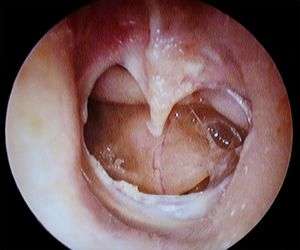Otic barotrauma
Background
- Also known as "ear squeeze" - generally seen during scuba diving or air travel
Clinical Features

Perforated TM
Middle Ear
- Results from inability to equalize middle ear pressure
- Pain, fullness, vertigo, conductive hearing loss, TM rupture
Inner Ear
- Results from forceful valsalva against an occluded eustachian tube, or rapid descent in diving or aviation
- Pressure difference between middle ear and inner ear can rupture oval or round window
- Sudden onset of sensorineural hearing loss, tinnitus, severe vertigo
- Must be lacking in any other neurologic signs (otherwise consider infarction)
Differential Diagnosis
Scuba Diving Emergencies
- Barotrauma of descent
- Otic barotrauma
- Sinus barotrauma
- Face squeeze
- Barotrauma of ascent
- At depth injuries
- Oxygen toxicity
- Nitrogen narcosis
- Hypothermia
- Contaminated gas mixture (e.g. CO toxicity)
- Caustic cocktail from rebreathing circuit
External
- Auricular hematoma
- Auricular perichondritis
- Cholesteatoma
- Contact dermatitis
- Ear foreign body
- Herpes zoster oticus (Ramsay Hunt syndrome)
- Malignant otitis externa
- Otitis externa
- Otomycosis
- Tympanic membrane rupture
Inner/vestibular
Evaluation
- Generally clinical
- Webber and Rinne for middle ear barotrauma
- Conductive hearing loss expected
Management
Middle Ear
- Decongestants
- Consider antibiotics if tympanic membrane rupture
- Remember to use medications such as ofloxacin suspension that will be safe in the middle ear
- Urgent audiology required if sensorineural hearing loss, rather than conductive hearing loss
Inner Ear
- Elevate head of bed
- Advise patient to not blow nose
- Antivertigo medications (e.g. meclizine)
- ENT consult
Disposition
- Generally may be discharged
- Resolution usually in 5-7 days, but can take up to 2 weeks
See Also
- Ruptured tympanic membrane
External Links
References
This article is issued from
Wikem.
The text is licensed under Creative
Commons - Attribution - Sharealike.
Additional terms may apply for the media files.